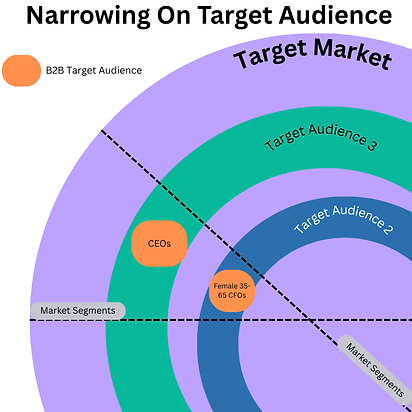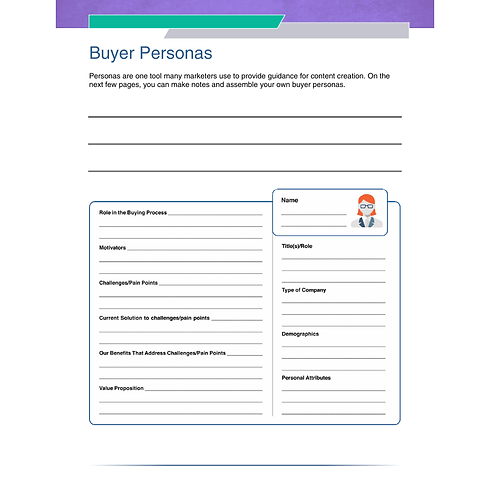Anuncier
Target Audience Strategies: How Do I Find My Target Audience?
Unlock better marketing results by understanding exactly who you're trying to reach.
Why Finding Your Target Audience Matters
At Anuncier, we work with organizations of all sizes—from startups and small businesses to nonprofits. And no matter the size or sector, one question always comes up:
“How do I find my target audience?”
It doesn't come up so formally, but we usually have to dive into that question after we ask, “Who is your product or service designed for?”—a question that often sparks deeper conversations.
Here’s a quick example. Not long ago, we worked with a small company developing high-quality training materials for the education market. The content was thoughtful, polished, and nearly ready for launch. They brought us in to help choose the right marketing channels. Naturally, we asked, “Who are these trainings for?”—in other words, “Who is your target audience?”
Their answer? “Anyone—parents, teachers, school administrators.”
That’s when we hit pause. That is not a Target Audience. While they had a target market—in this case, education—they didn’t have clearly defined target audiences. And that distinction matters, especially when it comes to recommending and implementing a marketing plan. You can (and often should) have multiple target audiences within a single target market. Why? Because multiple target audiences allow you to address the target market in a more holistic way. And if you try to speak to everyone the same way, you risk connecting with no one. Going back to our example the messaging that would resonate with parents is different from the one that clicks with a school administrator. Even though in some cases they were selling the same educational course.
Understanding your target audience empowers you to:
✅ Craft messaging that speaks directly to your audience’s needs
✅ Choose the right marketing channels for each group
✅ Improve your conversion rates with tailored outreach
✅ Use your marketing budget more efficiently and effectively



What Is a Target Audience?
Your target audience is a specific group of people most likely to want or need your product or service. These are the people you should be speaking to directly in your marketing efforts. While in the same target market, their pain points or challenges will be different.
Your target market is the broader industry or group (e.g., “education industry”), while your target audience is a smaller, more defined segment (e.g., “elementary school teachers looking for SEL resources”).
B2B vs. B2C Target Audiences
Whether you’re selling to businesses or individual consumers determines how you’ll define and reach your audience. Your business model will go a long way to determining the best way to finding your target audience.
🏢 B2B Target Audiences:
For B2B companies the target audience are typically going to be the people who would buy your product or service, in other words the role or function within another organization. Typically most B2B transactions require multiple people to evaluate, decide, and pay for those products and services. Understanding what role you are targeting and their common pain points will be the basis critical for marketing campaigns. The specific business function is a necessary characteristic for B2B target audiences.
Other characteristics might include:
-
demographics
-
Interests and lifestyle,
-
attitudes and opinions.
-
break down of companies by vertical
-
break down of companies by size (large organization CEO vs small organization CEO)
Target audiences can get very sophisticated with additional geographic, stakeholders (board members for example), and outside partners (consultants as an example) characteristics. The more defined you can get will help, however you want to be able to scale marketing activities so there is a balance needed.
🛍️ B2C Target Audiences:
Generally when we look at target audience characteristics we look at psychographic, behavioral, or even geographical data. These are good in breaking down different demographics which might be part of the target market. There are tools like AIO variables, and VALS that can help provide a framework for those additional characteristics. Is it possible to have demographics be a target audience characteristic? Yes! A quick example can highlight this. Let’s say a nonprofit focuses on providing substance abuse recovery services to males. Their target audience might be males ages 18- 45. Their target audience could include characteristics like employment status and location. Having this understanding of your target audience will provide a roadmap on the best marketing channels to use. Most small businesses, startups and nonprofits will have many different types of target audiences - ergo and different channels to reach them. This begs the question of what determines how many target audiences you have. This can be more art than science, but at Anuncier we generally recommend creating new target audiences when there are different pain points or perceived value change in your product or service.
Summary of Target Audiences for B2C companies:
-
Usually starts with a demographic breakdown.
-
Can be further defined by psychographics, behavior, and lifestyle (or even more demographics)
-
Purchasing decisions are often personal, emotional, and individual
-
Messaging should highlight benefits, convenience, or values alignment
How Do I Find My Target Audience? Practical Steps for Startups, Small Businesses, and Nonprofits
While there are myriads of options to get data to find your target audience, you may be wondering how do I find my target audience, without going through a complex process or spending a lot of money on market research. The key is to start small and simple—you can always expand as you grow. At Anuncier, we guide clients through an easy, practical process. We want to use resources that are no-cost or low-cost to develop a target audience. Initially, we might have a more generic target audience, and then get more and more specific. In our example above, we might just narrow our target audience to a younger male demographic - while this isn't as specific as above it will at least get us started on what marketing channels would best resonate.
Steps to find your target audience using existing resources
First, look at what you already have: tap into Google Analytics, CRM data, and purchase history to spot trends among your current customers. If you're just getting started or want to expand beyond your existing base, conduct basic market research. You can gather valuable insights through surveys, interviews, social media listening, and industry reports. Simple tools like SurveyMonkey, Typeform, Facebook Polls, or apps like FER make it easy to collect feedback. Remember, you don't need a perfect picture right away. Starting with even a few key details about your ideal audience can make your marketing more effective—and you can refine your approach over time as you learn more.

Customer Segments versus Target Audiences
Target audience, especially for B2C, and customer segments are understandably often overlapped. In many cases the same characteristics that are used to define customer segments can be used to define a target audience for B2C organizations. The biggest distinction between the two terms is that target audiences tend to be more prospect or future facing, while customer segments would be a way to look at existing clients.

Buyer Personas: Bring Your Target Audience to Life
Buyer personas are a powerful tool for bringing your target audience to life. There are many ways to create buyer personas, and the specific information you include will often vary depending on your industry. To the left, you’ll see the first page of a template we use to build personas (we’re happy to share the rest—just reach out to us!). One exercise we always recommend is mapping out what a typical day looks like for your persona before they use your product or service, and after they’ve worked with you.
Pro Tip For Buyer Personas
We suggest involving different departments in the creation process. Having input from sales, marketing, customer service, and other teams will give you a more complete, accurate persona—one that resonates across your entire organization.
Target Audience: Don't Guess And Be Clear
Building your marketing strategy without a clearly defined target audience is like throwing darts in the dark. You want to be as clear as ocean blue water!
At Anuncier, we help organizations like yours cut through the noise and speak directly to the people who matter most. Whether you’re launching a new product or refining your outreach strategy, identifying your audience is the first step to lasting impact.
Need help finding your target audience?
